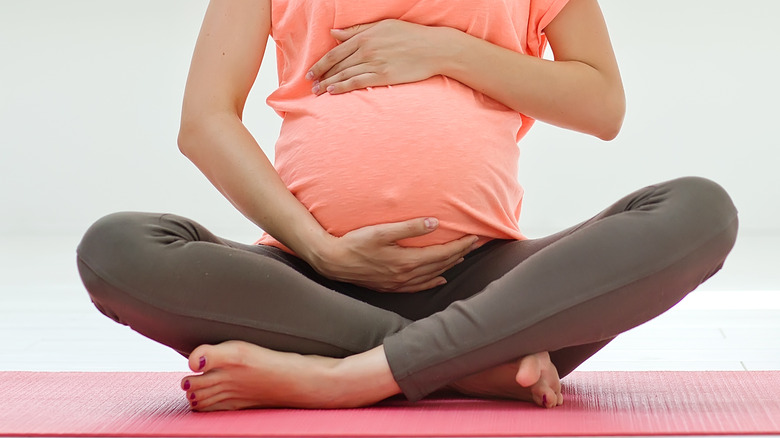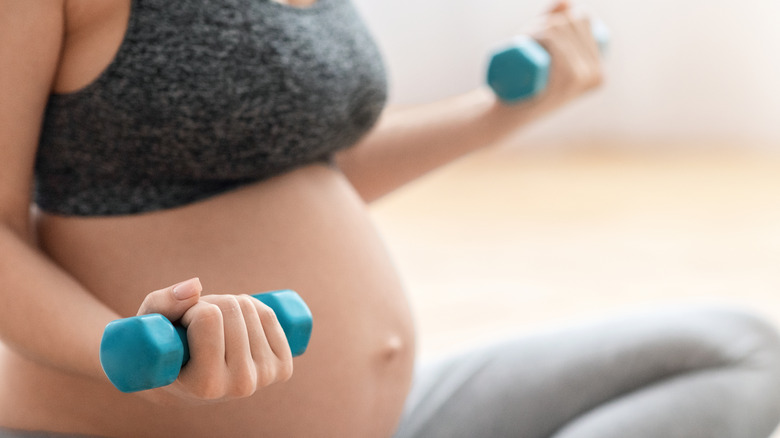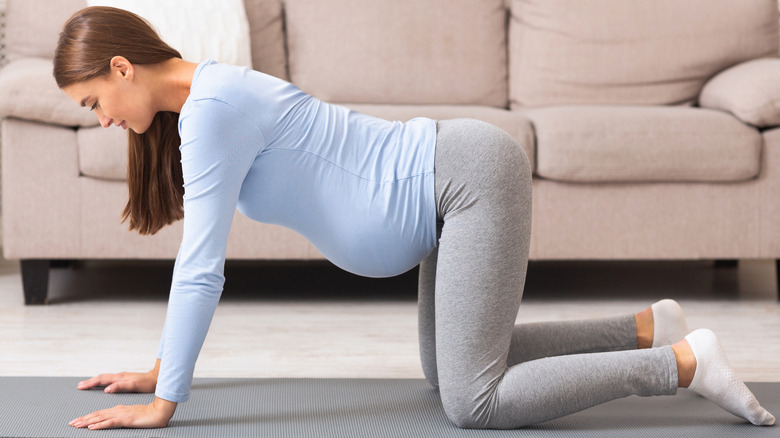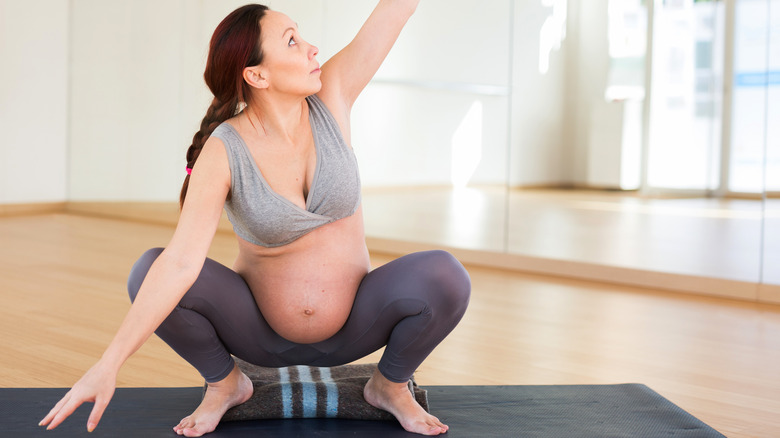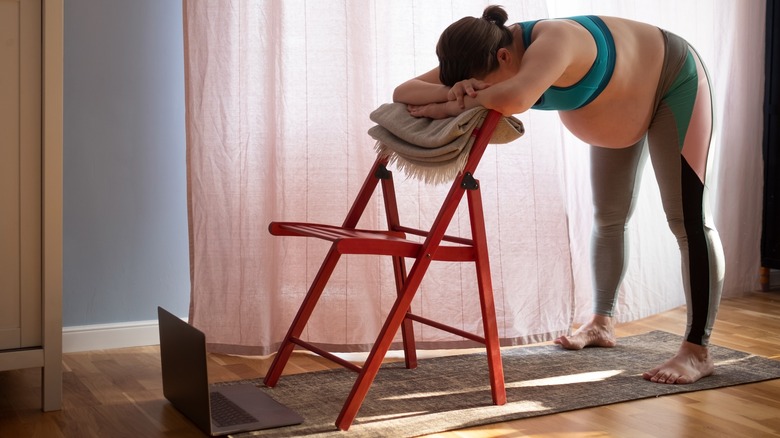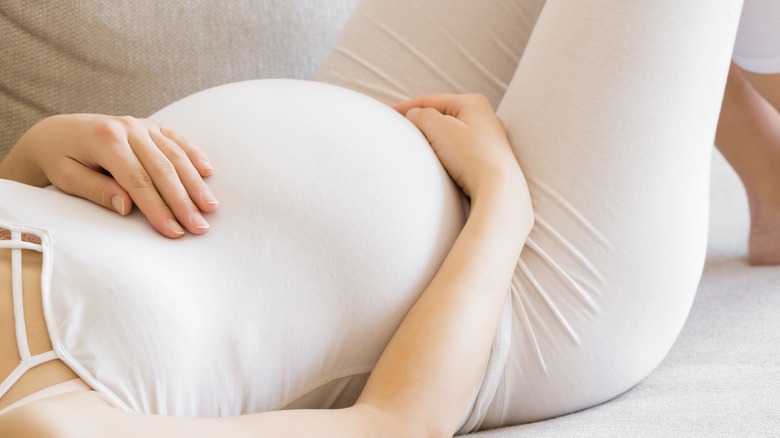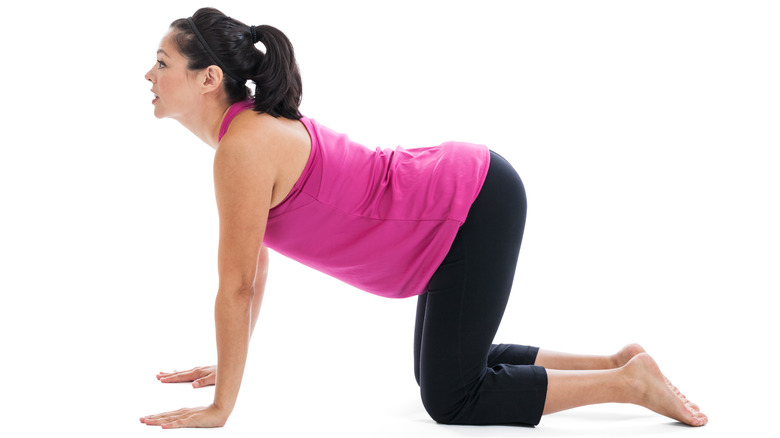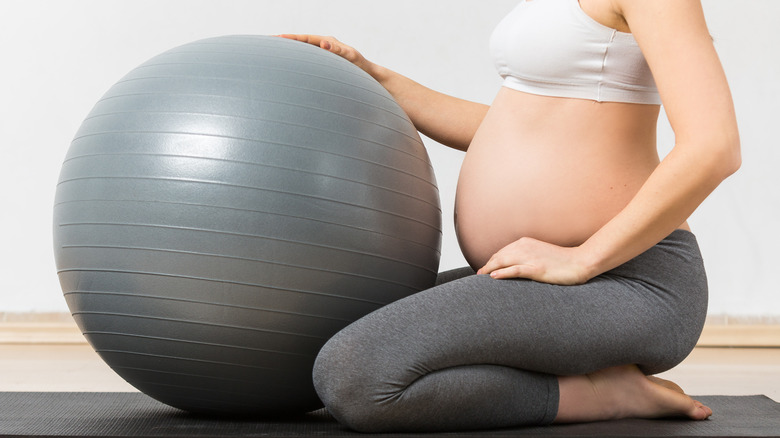The Best Exercises To Help Induce Labor
Are you ready to meet your new baby? If your due date came and went, you may be considering some different tactics to help move labor along.
Many moms-to-be are willing to try anything to jumpstart labor, like trying spicy foods — even if that means potentially experiencing heartburn (per What to Expect). If that's the case for you, then you may want to consider giving certain exercises a try. According to midwife and maternity consultant Kathy Fray, if your cervix is soft and ready for labor, exercise may help initiate contractions (via The Bump). However, if your cervix "isn't ripe" yet, then no amount of exercise will help you go into labor.
While there are no proven ways to safely induce labor at home, there are things you can do to help get your baby in the best possible position for birth. As always, be sure to talk to your doctor first and get their approval before you attempt any exercises. Once your doctor gives you the go-ahead, then you can try the following routines to help induce labor.
When is it safe to do exercises?
Like many moms-to-be, toward the end of your third trimester, you're probably pretty anxious to get things moving along. If you've reached 39 weeks, then you've officially made it to what is considered a full-term pregnancy (via The American College of Obstetricians and Gynecologists). At full term, your baby has the best chance of being healthy; if it's born too early, it may have health issues (per March of Dimes).
According to Healthline, regular exercise is safe for most women throughout pregnancy, and may even lower your risk of pregnancy-related conditions like preeclampsia and gestational diabetes. However, it's not safe for all pregnant women to use exercise to help induce labor. If you're on bed rest, have a history of premature labor, have a condition such as placenta previa, preeclampsia, or high blood pressure, or have weak cervical tissue, then exercising during your pregnancy is highly discouraged. However, if you've been exercising throughout your pregnancy, you can keep it up. If you don't currently follow any type of exercise plan, then make sure you talk to your doctor before you try anything new.
Walking
A popular approach to induce labor at home is to go for a walk. But can it really bring on labor? If you're considered a low-risk pregnancy and are 38 weeks along or further, then walking three times a week for 30 minutes may help to enhance labor, per a 2022 study in the Journal of Maternal-Fetal & Neonatal Medicine. According to Estela DiFranco Field, midwife and associate medical director at North Carolina's Duke Birthing Center, walking can help your cervix get ready for labor (via Live Science).
Your body goes through a lot of different changes before your baby can be delivered. While walking on its own won't induce contractions, it can take pressure off the cervix by helping to release a group of hormones called prostaglandins. This allows the cervix to thin and soften sooner than it normally would, which in turn helps the child "settle into the pelvis" and prepares it for birth.
Breathing techniques
Aside from exercise, you may want to try some breathing techniques, such as patterned breathing, to successfully and safely coax out your baby.
Patterned breathing is exactly how it sounds: It's simply breathing at different speeds and depths until you find a pattern that works for you (per American Pregnancy Association). Once you play around with different types of breathing (slow, accelerated, variable), then you can choose which method to use during labor to help calm and relax you. You can also try one of these breathing techniques to help induce labor.
Melissa Green, a labor support doula in New York City, says you can try a method called engaged breathing. As she tells The Bump, engaged breathing involves contracting the abdominal muscles as you inhale nasally, as opposed to normal breathing (in which the core and diaphragm are engaged upon exhaling). She describes it as "[trying] to hug the baby with your abdominal muscles." As you practice this technique, the muscles in your pelvic floor will relax as you exhale.
Cat-cow pose
If you're looking for a gentle way to self-induce labor or help ease any discomfort, then you may find yoga to be helpful. The cat-cow pose is a simple way to relieve tension in your spine, neck, torso, and shoulders (via Healthline). It's also a great exercise to get your baby in an ideal position for labor, says prenatal yoga teacher Jennifer Coulombe (via Romper).
To give this exercise a try at home, start on all fours in a tabletop position, making sure your hands are directly under your shoulders and your knees are directly under your hips. Once in position, move your pelvis forward and backward rounding your back as you breathe in for about 30 seconds (via Cosmopolitan). If you feel any pain or pressure on your knees, place a towel or blanket under them or fold your yoga mat in half. If you feel any pain anywhere else while practicing this move, stop immediately.
Deep squat
If someone told you that squatting will bring labor on faster, would you try it? While the idea of squatting down and not being able to get back up may sound daunting, squats are actually a great exercise to do throughout your pregnancy because they help to prepare your pelvic floor for labor. Each time you bend down to squat, you're stretching your pelvic floor, and as you resume your standing position, you're lifting it (via What to Expect). While there's no scientific evidence that squats will induce labor, they can help encourage your baby to move its way down the birth canal.
To try this move at home, Healthline recommends standing with your feet a little wider than your hips, pointing your toes outward. Next, slowly squat down like you're about to sit on a chair, but continue downward so you're in a deep squat and your butt is driven back. Place your palms together at your chest while you hold this position for about 30 seconds. If you need additional support, position yourself near a wall or chair, or sit on a yoga block or rolled-up towel.
Forward leaning pose
If you're looking for a way to increase your chances of having an easier birth and maybe even kickstart labor, then you should try the forward-leaning inversion. While this exercise may look intimidating, it's a great exercise to get you ready for labor (via Lamaze). It also helps to untwist any unbalanced ligaments supporting the uterus, allowing for your baby's head to align just right in your pelvis.
To try this at home, kneel on a high surface such as a bed or a couch (via Spinning Babies). Carefully lower your hands to the floor so your hands or forearms are on the ground and your head is hanging downward. Tuck your chin in and take three deep breaths. Lift yourself back up so you're sitting on your knees, then take two more deep breaths. If this position seems too difficult, you can ask someone to assist you, or you can try a simple forward learning pose where your arms and head are rested on a chair in front of you.
Kegels
As you wait for your baby to make its big debut, you may want to consider doing some Kegels. Kegels are something that you can do anytime and anywhere, and no one would even know you are doing it (via Body Mind).
Kegel exercises are quick squeezes that help strengthen your pelvic floor muscles. Once you locate your pelvic muscle, squeeze them for a count of ten then release them. Do this a few times, taking a moment to breathe and relax each time afterward. By strengthening your pelvic floor, you are toning your muscles, which will help you gain control over them when you have to push during labor (via American Pregnancy Association).
Other benefits include less urinary leakage when laughing or sneezing and a reduced chance of hemorrhoids, as well as the fact that it can shorten your labor when pushing out the baby. While Kegels may not put you into labor, doing them regularly can make it easier for you to control your muscles when that fateful moment comes.
Pelvic tilts
As you know, being pregnant can do a number on your back and pelvis. To help stretch your spine and relieve some back and pelvis pain, you can try some pelvic tilts. Pelvic tilts or "pelvic rocking" is a good way to help with pain, as well as give your baby that much-needed nudge to move down into the birth canal (per Healthline). As you get ready for labor, performing these exercises on a birth ball can also help correct the position of the baby, says a 2019 study in the International Journal of Women's Health and Reproductive Services.
To try this exercise at home, Baby Center recommends getting down on all fours so your hands and knees are on the floor. To ensure you're in the correct position, your arms should be shoulder-width apart, and your knees must be hip-width apart. Once you make sure your elbows are unlocked, take a deep breath in, curling your spine inward. Then, return to a neutral position as you exhale. Do this three to five times as you follow the pace of your breath.
Exercise birthing ball
Another way to get into the delivery room faster is to try out an exercise birthing ball. While it may not get you into labor, it can help get the ball rolling so your baby is in the right position (via New Kid Center).
Sitting on the ball can help to open up your pelvic region and put pressure on your cervix, which can encourage the uterus to contract. If your baby is breech (which is not the correct position for delivery), move up and down or sway on the ball. This can help guide your baby into the right position, so they can descend the birth canal correctly. An exercise birthing ball can also help the blood to flow to your pelvic region quicker, which will in turn keep your baby healthy.
With that said, before you use an exercise ball to help induce labor, be sure you get the go signal from your doctor.
Slow dance
If you're looking for a fun way to bring yourself closer to labor, then try dancing the baby out of you. While it may not directly induce labor, it can help move things along once you're in labor (via Southdale Obgyn).
We're not suggesting any wild dance moves, though — just some slow dance moves that will help open your hips and pelvis and speed up dilation. To help you progress through labor, Lamaze suggests slow dancing with your partner by swaying your hips side to side. This will help the baby to descend, as well as relieve any discomfort.
If you're not a high-risk pregnancy or have any other serious health issues, then it's okay to try and induce labor by dancing, according to Michigan State University professor Dr. James Pivarnik (via Self). Additionally, he doesn't suggest performing any dances for an extended period of time. Instead, some moderate dancing to a few songs may help get the labor to progress.
Happy baby pose
If you've ever seen a baby on its back, holding its feet and rocking back and forth, then you've witnessed the happy baby pose. This pose, referred to as "Ananda Balasana" in the yogi world, is a calming yoga pose with many benefits, says Healthline. It can help to ease stress and anxiety, lower your heart rate, and alleviate lower back pain, and it's also a great hip opener.
To try the happy baby pose, lay on your back and place a few pillows under your head and back (via Pure Wow). Grab your feet or ankles and just lay there or gently rock back and forth. Next, find your diaphragmatic breath. You can do this by placing one hand on your chest and the other on your stomach (per Harvard Health Publishing). Breathe in through your nose (feel your belly rise), then out through pursed lips (feel your belly go back down).
Stair climbing
If your hospital bag is packed and you're still not getting any contractions, then you may want to consider climbing some stairs to get the ball rolling. Any movement is said to help jumpstart labor, even something as simple as going up and down a set of stairs (via Healthline). The back-and-forth motion of stair climbing helps to open your pelvis and position your baby to come further down the birth canal, which can accelerate dilation (per Lamaze).
If the idea of climbing stairs seems too strenuous, then you can try a different technique to induce labor, curb walking (via Wonderbaby). Walking with one foot on the ground and the other on the curb is said to assist in opening your pelvis just like how climbing stairs would. The rocking motion can help gravity pull your baby downward. While you may feel silly while doing it, the fact that nearly a third of women identified walking (and other physical activity) as a labor trigger may make the awkwardness worth it (via a study in The Journal of Perinatal Education).
Sex
At this point, you're probably willing to do anything to get your baby out. Perhaps that includes having sexual intercourse with your partner, even when your belly is probably the size of a large watermelon.
While the idea may sound like a mood killer, research suggests that it may actually be a viable option. In a study published in a 2015 edition of the Iranian Red Crescent Medical Journal, researchers examined if sexual intercourse during pregnancy would lead to an onset of labor. Interestingly, their findings showed that sex during the last week of pregnancy might be associated with inducing labor.
According to What to Expect, your partner's sperm contains hormones called prostaglandins, which are known to help get your cervix ready for delivery. So, before you throw the idea out the window, if you're thinking of exploring your options for thinning and dilating your cervix, a bit of sexual intimacy just might be the key.
Signs that indicate the start of labor
As you anxiously await the arrival of your baby, you may be wondering what signs you should be looking out for that will indicate the start of labor.
While every pregnancy is different, there are a few early and commonly observed physical indicators of labor, says Dr. Jonathan Emery (via the Cleveland Clinic). The first sign: period-like cramps that may come and go. These cramps may hint at mild contractions that could anywhere between few hours and two days. The next sign is pelvic pressure, or pressure that is felt in your lower back or vagina. This may indicate that your baby is getting into position.
You may also notice changes in your vaginal discharge, which could be pointing to the loss of your mucus plug. Lastly, if the consistency or color of your vaginal discharge changes, you may be going into labor within a day or two. If you experience any of these symptoms and begin feeling strong contractions that take place at five-minute intervals, call your doctor immediately.
